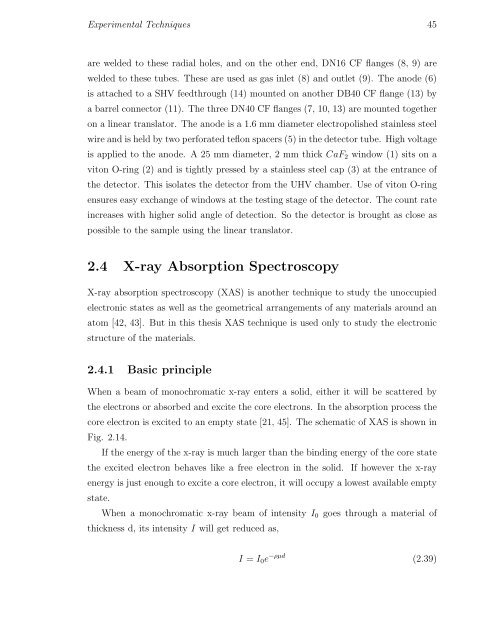PHYS07200604007 Manas Kumar Dala - Homi Bhabha National ...
PHYS07200604007 Manas Kumar Dala - Homi Bhabha National ...
PHYS07200604007 Manas Kumar Dala - Homi Bhabha National ...
You also want an ePaper? Increase the reach of your titles
YUMPU automatically turns print PDFs into web optimized ePapers that Google loves.
Experimental Techniques 45<br />
are welded to these radial holes, and on the other end, DN16 CF flanges (8, 9) are<br />
welded to these tubes. These are used as gas inlet (8) and outlet (9). The anode (6)<br />
is attached to a SHV feedthrough (14) mounted on another DB40 CF flange (13) by<br />
a barrel connector (11). The three DN40 CF flanges (7, 10, 13) are mounted together<br />
on a linear translator. The anode is a 1.6 mm diameter electropolished stainless steel<br />
wire and is held by two perforated teflon spacers (5) in the detector tube. High voltage<br />
is applied to the anode. A 25 mm diameter, 2 mm thick CaF 2 window (1) sits on a<br />
viton O-ring (2) and is tightly pressed by a stainless steel cap (3) at the entrance of<br />
the detector. This isolates the detector from the UHV chamber. Use of viton O-ring<br />
ensures easy exchange of windows at the testing stage of the detector. The count rate<br />
increases with higher solid angle of detection. So the detector is brought as close as<br />
possible to the sample using the linear translator.<br />
2.4 X-ray Absorption Spectroscopy<br />
X-ray absorption spectroscopy (XAS) is another technique to study the unoccupied<br />
electronic states as well as the geometrical arrangements of any materials around an<br />
atom [42, 43]. But in this thesis XAS technique is used only to study the electronic<br />
structure of the materials.<br />
2.4.1 Basic principle<br />
When a beam of monochromatic x-ray enters a solid, either it will be scattered by<br />
the electrons or absorbed and excite the core electrons. In the absorption process the<br />
core electron is excited to an empty state [21, 45]. The schematic of XAS is shown in<br />
Fig. 2.14.<br />
If the energy of the x-ray is much larger than the binding energy of the core state<br />
the excited electron behaves like a free electron in the solid. If however the x-ray<br />
energy is just enough to excite a core electron, it will occupy a lowest available empty<br />
state.<br />
When a monochromatic x-ray beam of intensity I 0 goes through a material of<br />
thickness d, its intensity I will get reduced as,<br />
I = I 0 e −ρµd (2.39)
















